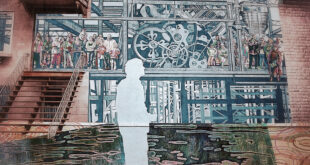This paper was presented at a seminar on "Media and the Muslim world" held at George Washington University's Department of Religion in April 2002.
Our topic-Media and the Muslim world-is broad enough to support a two-day conference and susceptible enough to change, given the nature of media and the circumstances of the Muslim world, to be repeated on an annual basis.
And in the end all I am really to do here today is to introduce a film-a video documentary-in the context of our topic. The video, for those of you who have managed to find your way to this room without quite understanding why, is "Rumi: Wings of Love," written, directed, and produced by Shems Friedlander, my colleague at the American University in Cairo and a dear friend. We are New Yorkers and, in homage to our city and its once great garment industry, you might say that today I will mark and Shems will cut.
So what I will try to do today in the very limited time that we have is to introduce some concepts that I consider basic in trying to fathom the nature of media, and then focus those concepts on one particular branch-television-and in particular on satellite broadcasting and the related formats of television journalism and video documentaries as these relate to the Muslim world and, finally, to the video we will be watching today.
When we say media we mean "mass media"-in other words messages mediated by technology, or, in transmission terms, messages that are impersonal in their transmission or potential transmission to large undifferentiated audiences. "Undifferentiated" is an academic way of saying that the audience is any Tom, Dick, or Harry who might be reading, or listening to, or watching a media product mediated by technology, and not somebody I know or could easily know in the way that the Imam of a mosque giving a khutba or a priest giving a sermon knows or theoretically could know anyone in his audience. I've chosen this example because the khutba or sermon most closely approximates mass media but, as long as it's not on TV, radio, or even conceivably a public address system, it's not that; which is probably one of the reasons why the PA system in the mosque-to the degree we are conscious of it, meaning it's a bad one (and I can assure you that in Cairo, almost all of them are)-is potentially so disruptive. In other words, to the degree we become conscious of technology imposing itself between the Imam and ourselves, the acoustically nasty intervention becomes not only offensive to those with an ear for beauty but ruptures the potentially personal relationship between ourselves and the Imam or myself and the priest.
When we say media but mean mass media - communication mediated by technology that turns it into a mass communication-we are saying "modern." I would argue that the phrase "modern mass media" is a redundancy; indeed, Eisenstein-not the film maker but the most interesting historian of mass communication-suggests this is true to such a degree that the printing press should not be perceived as the product of the industrial revolution as is typically done in formulations of the causal equation that is made for the modern age. Rather, Eisenstein says, it is the invention of the printing press that so shifted the context of Western culture as to facilitate the Protestant Reformation and the industrial revolution.
Here is an aside: for those here who might be considering graduate work in Islamic, Arabic, or Middle Eastern studies, I would suggest considering, as a research area, the role of the printing press in rupturing the transmission of traditional knowledge in traditional Islamic civilization. For that civilization was preserved and passed on to a far greater extent in the form of manuscripts - by what we call scribal culture-than the equivalent traditional culture of the West, where manuscripts were far fewer and far more restricted in readership and where the transmission of traditional culture made far more extensive use of alternative mediums of communication, particularly visual representations such as stained glass portrayals of New and Old Testament events and the martyrdom of the Saints.
The impact of the printing press in the West was stretched out over centuries and the relatively few manuscripts were to a large degree reproduced in printed form in the first century, a century that by Eisenstein's reckoning pre-dates modernity and its rival literatures. Not so in the Arab-Islamic world: the first printing press was set up there in the early 19th century and, while a small portion of the Islamic equivalent of the "Great Books" were reproduced, a vast stock of modern literature, either imported and translated or derived from such imports dominates the present-day Arabic library, while more than a million manuscripts-the rich storehouse, so to speak, of traditional culture-linger on neglected and gathering dust in national and mosque libraries and in private collections.
Islamic architecture is one of my concerns and I always assumed that the extraordinary break between the product of most modern Arab or Muslim world architectures and the extraordinary architectural product of traditional Islamic culture should be understood in psychological and social terms. However, my own recent work indicates this can also be located in the unread manuscripts-unread, let us assume, since the mid-19th century-that had once played a role in the transmission of the methodologies and conceptual understandings of Islamic architecture.
When we jump from print to television we move into still another profoundly revolutionary cycle of communication. Television is electronic-it is not photography (as we knew it up to the recent introduction of the digital camera). Photography as we have known it in its 200 year old history is, like print, inseparable from the industrial revolution: it is a mechanical form of reproduction. TV, video, DVD-whatever is electronic-is inseparable from the electronic revolution of the computer, of IT.
Now the spiritual problem in electronic media is that there really is no image out there, as is the case with personal visual perception or even with the shadow of the image, which participates Platonically, one might say, in the real image that it is the shadow of. The electronic image doesn't exist - scrape the videotape and you won't find anything, no negative prints - it's all electronic spirals that are at best digitalized and the image is what we reconstruct from all the moving dots of electronic energy carrying information. I think that is why baraka-spiritual grace-doesn't "track" (record electronically), whereas in black and white photography of saints we can at times more or less "see" the light that Saints are known to reflect or we can see the otherwise invisible human aura in X-rays which Soviet scientists, of all people, established as a direct manifestation of the power of faith healers.
Now religion, according to Al-Ghazali, is belief in the invisible world, but in television only the visible appears to be real, only the visible appears to exist. TV, more than any other form of mass medium, intrinsically rather than formally denies metaphysical reality. And all of this, of course, flies in the face of but can potentially overcome that existential knowledge of the reality of baraka that has been experienced by much of mankind over thousands of years in its response everywhere in the world to the presence of saints and sacred sites. That is why in the Muslim world millions of believers still visit the tombs of saints and experience baraka, or experience it in the concentrated repetition of the divine Names (dhikr allah), none of which experiencing of the sacred can be tracked.
On the other hand, those of us who are TV professionals know that it is movement and visible emotion-close-up-that makes the best TV picture.
That may be one of the reasons, in addition to the market-share rewards of sensationalism and the secular biases of the TV News networks' managerial elite, that sex and violence are such attractive subjects for TV and why so little about religion appears on TV news except when it provides images of violence. (To date we have been relatively spared images of the sexual dimension in religion, though who knows how "reality TV" will treat another Rev. Jimmy Swaggert, down the road).
Even in the modern Arab-Islamic world, and particularly in the age of transnational broadcasting, how many still read Al-Ghazali and how often are his concerns echoed on religious programs, which have been tilted amazingly in the direction of the salafite tendency? Just as public affairs debate shows on Arab transnational television are frequently debates between a guest with an anti-American perspective and one with a super-anti-American perspective, so too transnational Arab satellite religious discourse is often between the salafite and the radical salafite. Perhaps that will now change given the now obvious destination of radical salafite thought.
So what is to be done? One possibility is the sort of video that Shems Friedlander has produced: it does not hesitate to use the "talking head" because if the human voice is employed as more than a sound bite, as more than a brief cutaway between images, there is a possibility, as doors open, for the transmission of profound insight.
And it is through this film's very harnessing of movement (movement for the sake of God and not for viewers' titillation, but movement nevertheless) that so often characterizes the circles of the lovers of God, of those who gather to "remember God," that TV's barriers to spiritual insight may be overcome.
 Arab Media & Society The Arab Media Hub
Arab Media & Society The Arab Media Hub




